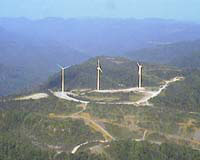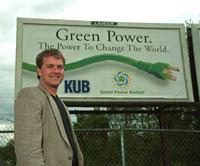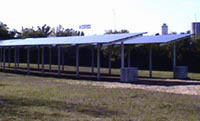Ulla-Britt Reeves is the clean air program director for the Southern Alliance for Clean Energy. Although she is a native West Coaster, she has lived and worked in the East for six years. Before her job at SACE, Ulla worked for an international volunteer agency in Virginia.
Monday, 13 Nov 2000
KNOXVILLE, Tenn.
We had a lovely fall morning here in east Tennessee — the sunrise cast brilliant pink reflections across the patchy sky — the start of a good day. From my office window I can see the Great Smoky Mountains nearly 50 miles away. Clear visibility like this is unusual due to the frequently hazy skies around here, but when the winter high pressures come and dry, cold air moves in, we get a glimpse of the true beauty of the area’s geography.
As the clean air program director at the Southern Alliance for Clean Energy (SACE) — formerly known as the Tennessee Valley Energy Reform Coalition — I work primarily on the coordination of the Tennessee Clean Air Task Force, which is part of a national campaign against dirty power. (I’ll be co-writing this diary week with our executive director, Stephen Smith.)

Here are our new turbines.
Today, SACE staff, Tennessee Valley Authority (TVA) representatives, and area media traveled to Buffalo Mountain just north of Oak Ridge, Tenn., in the Cumberland Mountains for a dedication ceremony to celebrate and announce the completion of a project to bring three state-of-the-art wind turbines online — the first such project in the Southeast. On Earth Day 2000 last April, the TVA rolled out its new renewable energy program, Green Power Switch (GPS). Green Power Switch is third-party-certified by the Center for Resource Solutions and designed to give TVA customers the opportunity to pay four dollars more on each monthly utility bill in order to receive clean energy. This isn’t a foreign concept to many folks in the U.S. these days, but this program is the first of its kind in the Southeast and was quite an accomplishment, given TVA’s reluctance in the early ’90s to offer renewable options.
SACE was the lead organization that helped GPS become as successful as it has been. We have three full-time staff equivalents working to promote GPS in the 12 distributor market areas participating in the program. Our task is to see that there is a 1 percent market penetration of GPS sales in the first year. TVA will then agree to a larger corporate commitment if we can show the demand in the valley is high for renewable energy. Although the overall size of the program is small (eight megawatts) in comparison to TVA’s total size and energy output (29,000 megawatts), we hope that this is a step in the right direction for penetrating the market and helping drive down the cost of renewable technologies in the future.
Our organization is nearly 20 years old if you trace its roots back to its inception as the Tennessee Valley Energy Coalition (TVEC) in the early 1980s. TVEC was originally designed to be an advocacy organization for ratepayers in the valley, as well as to track the environmental friendliness of TVA’s energy policies throughout the ’80s. Early program issues were tracking the overbuilding of TVA’s nuclear program and promoting conservation efficiency.
In the early 1990s, a group of regional environmental groups came together to refocus TVEC specifically on TVA energy policies. TVA, a federal entity created by Franklin Roosevelt in 1933, has a mission to be the “power of the public good” and was designed to generate prosperity in the valley, provide affordable energy, and support the river system. But TVA is also the largest utility company in the U.S. with an enormous environmental footprint — 63 percent of its energy output comes from burning coal.
So in the early ’90s, TVEC’s name changed to Tennessee Valley Energy Reform Coalition (TVERC) and efforts were ramped up to choke off TVA funding of nuclear expansion. Stephen Smith became the executive director in the spring of 1993. TVERC fought furiously and became renowned as the TVA Watchdog group, as it worked to stop TVA’s plan to bring on six new nuclear plants (uranium reactors). The group was successful in blocking the expansion of four units: Bellefonte (two reactors), Watts Bar unit 2, and Brown’s Ferry unit 1, but Watts Bar unit 1 and Bellefonte unit 2 were completed.
In 1995, the organization focused on TVA’s long-range Integrated Resource Plan (IRP) to place more focus on renewables and energy efficiency issues. TVA backed off its commitment to this program due to the threat of deregulation. Later, in 1998, TVERC and TVA rejoined efforts to successfully bring the Green Power Switch online.

It wasn’t a breeze to build these turbines.
In 1996-97, TVA came under attack from investor-owned utilities and threatened to back off of critical resource management issues in the valley. TVERC used its “watch dog” status to become involved in public land issues during this time. Recently, TVA created the Regional Resource Stewardship Council to seek advice from public and private sectors to “help TVA form strategies and policies and set priorities on the best practices for managing the natural resources of the Tennessee Valley.”
We’ve held onto the original mission of the organization “to keep TVA environmentally and economically accountable to the people it serves” throughout its ebb and flow of funding and programs, although recent changes have expanded our horizons. In 1997 we became involved as the lead organization of the Tennessee Clean Air Task Force working to clean up TVA’s coal-fired power plants and address air pollution issues in the valley. In 1998, Green Power Switch took off and has since become one of our largest program areas. In the spring of 2000, we changed our name to the Southern Alliance for Clean Energy to more accurately reflect the true nature and scope of our work (TVA’s service area touches seven states). The change also gives us the opportunity to use our successes with TVA to help spread renewables across the South and look for other ways we can encourage other utilities to change their energy policies.
Today is a significant day for Steve because it has been a long, slow battle for the past nine years to get TVA to commit to these turbines. To see the turbines turning gracefully in the wind today was both a beautiful and rewarding sight. A small but significant step forward.
This afternoon, at our staff meeting, we celebrated Libby Hill’s birthday. Libby, our associate director, turned 27 today. Libby joined SACE in the summer of 1999 having worked for the Arkansas Public Policy Panel. She is the program director for the Green Power program. All our staff members are anxiously watching the outcome of the presidential election.
Tuesday, 14 Nov 2000
KNOXVILLE, Tenn.
We’re working today on completing an action plan for the air and water quality subcommittee of a regional citizen planning group. It is a “visioning” process that we were asked to be involved in because of our experience and expertise working on clean air issues in the area. This afternoon, I’m meeting with an activist from Earth First! to talk about the approach we take on clean air issues with TVA in comparison to the tactics they might employ … that’s always interesting. Later, I’ll be talking with the Ten
nessee Environmental Council, a member group of the Tennessee Clean Air Task Force (TNCATF), to review the strategy plan for the 2001 campaign. We’re also writing an op-ed in response to Alabama Power Company’s rebuttal of the recently released Death, Disease, and Deadly Power report.

Air emissions from TVA’s Gallatin steam plant fly high into the sky.
Southern Alliance for Clean Energy has recently become more involved in Alabama clean air initiatives. A while ago, we realized that our regional power plant campaign (which only funds four states — Georgia, Virginia, Tennessee, and Florida) is not comprehensive enough to put the needed pressure on Alabama Power Company to clean up coal-fired power plants. Alabama Power Company has a history of simultaneously fighting clean air standards and being a good corporate citizen by helping to support lots of community efforts. We figure now is the right time to turn up the pressure. We’ve used our alliance with the Alabama Environmental Council to begin to explore funding and outreach options to use our campaign resources to target Alabama Power. With some initial seed money, we are now looking to begin coalition building for an “Alabama Air Team” similar to the TNCATF. Last month, we simultaneously released the Deadly Power report in Tennessee and Alabama, with press events in both Chattanooga and Birmingham.

A 25-mile and a 100-mile visibility view in the Smokey Mountains.
We’ve been working for over two years now on the Tennessee clean air campaign to educate residents of the valley about the air pollution problems here and encourage TVA to clean up their emissions. We have 15 coalition partners in the TNCATF, including the American Lung Association, the National Parks and Conservation Association, and the Sierra Club. The primary campaign goal is to pass legislation that would close a loophole in the Clean Air Act which allows older coal-fired power plants to pollute at higher rates than new power sources. We use grassroots campaigns like our summer Smokies Campaign to educate the public and generate constituent pressure on our federal representatives. Our national campaign, Clear the Air, provides much of the technical and resource support to aid in the success of our regional and state-based work. We’ve already released four of our own reports.
None of the Tennessee congressional representatives has cosponsored our legislation, but we’ve made other inroads to working directly with TVA. TVA has committed to put 18 Selective Catalytict Reductions on its power plants to reduce the ozone-forming nitorgen oxides by 2005. In the meantime, though, TVA still won’t commit to reducing the sulfur dioxides that form the fine particulate matter that is so damaging to lungs. EPA has sued TVA over New Source Review (NSR) provisions of the Clean Air Act and we have actively encouraged TVA to settle the negotiations rather than draw the argument out in a long, protracted court battle. Unfortunately, negotiations aren’t happening immediately. The National Parks and Conservation Association has filed citizen suits on both the NSR case and on opacity violations at plants near the Smokies. SACE is looking to file on the NSR case as well within the next several weeks.
That’s our air campaign in a nutshell. Tomorrow, we’ll talk about coal waste and mountaintop-removal efforts with TVA.
Wednesday, 15 Nov 2000
KNOXVILLE, Tenn.
Steve and I are headed to Philadelphia this afternoon for a funders meeting with Pew to discuss our Southeast regional air campaign. We’ve spent a lot of time lately thinking about our Tennessee strategic plan and have begun to consider the possibility of taking on the regional coordination of the campaign (if it gets funded). It’s been stressful to think about the changes this would entail within our organization and the Tennessee air campaign. At the same time, it would be a neat opportunity to work with our other state partners. We’ve already been doing some of the regional work in some ways, since we’ve been administering our regional website for about a year now.
The Southeastern Power Plant Cleanup Campaign (SEPPCC) site compiles all of the state campaigns on one website, which gives us a unified look and combines the resources of the different campaigns. We are currently working with TechRocks to develop our online campaign strategy and redesign parts of the site. The best feature of the page so far is our plant-by-plant specifics section where you can “get the dirt” on each of the area’s coal-fired power plants. We are working with our national campaign partner Clear the Air to incorporate a grassroots management system so we can have both regional and national action alerts.
We have a call this morning to strategize for the meeting tomorrow. We also have a lunch meeting today with Paul, the newest addition to our air team. Paul is working on our economics report on cleaning up TVA’s coal-fired power plants. The report is intended to identify the hidden costs that air pollution already imposes on our communities. The costs of health problems, tourism loss, crop loss, and damage to the environment far outweigh the monetary burden imposed on utilities to retrofit and/or retire their dirty, old power plants.
We’ve also started thinking recently about other costs of burning coal. We live in the southern Appalachians — coal country. In nearby northern Tennessee, Kentucky, and West Virginia, there are miles of mountains devastated from strip mining and coal waste. The life cycle of coal, from the mine to the ash pond, leaves an enormous environmental footprint, and we’ve decided that TVA needs to hear about this. We meet quarterly with TVA in Green Group discussions. In these sessions, environmental groups working on a myriad of issues come together to express concerns about TVA’s environmental stewardship in the service area. For some time now, we’ve been discussing both our air and green power work in this venue.

A MTR site in Kentucky.
Recently, we thought to research TVA’s coal purchasing agreements to see if TVA is buying coal from companies that use mountaintop-removal (MTR) mining techniques. We flew up to Kentucky and West Virginia last month to take footage of MTR sites so that we could show this to TVA in conjunction with information on the companies. Our goal is to get TVA to rewrite its purchasing agreements to incorporate language that would make it impossible for them to accept any coal from MTR sources. The destructive nature of MTR is widespread. The percentage of coal removed from a site is not proportional to the amount of land destroyed. There are other mining techniques are less environmentally damaging, and we believe that TVA should focus on those.

A shot of the spill in Kentucky from above.
Our initial communications with TVA have produced some interesting questions and “fuzzy
” definitions of MTR, but we’re moving forward and are hopeful that with our footage and good research, we’ll convince TVA to change their purchasing policies. We have also showed TVA shots of the recent coal spill in western Kentucky. An impoundment slurry broke on October 11th, sending 250 million gallons of coal sludge (a larger volume than the Exxon Valdez oil spill!) down two sides of the mountain and blanketing two watersheds for miles downstream. The spill killed wildlife and plants for miles and devastated water supplies and homes. Black water containing mercury, chromium, arsenic, and a variety of other toxins made its way to the Ohio River within five days of the spill. Martin County Coal (a subsidiary of AT Massey and Fluor) was responsible for the spill and has been very subversive in dealing with the disaster. Media was not openly allowed to view the spill for days following and the national media was conveniently kept from publicizing the disaster, despite the fact that this has been called the largest environmental disaster in the southeast.
All the more reason to keep talking about renewable energy and breaking the dependence on coal. There are no easy answers to meeting our energy demands without burning coal, but then again, the real costs of burning coal outweigh the long-term costs to expand our use of renewable technologies. That’s all for now. Tomorrow, we’ll talk regional stewardship.
Thursday, 16 Nov 2000
PHILADELPHIA, Penn.
I’m writing this entry early this morning since the day will be tied up. Today, Steve and I are in Pennsylvania to meet with Pew, funders (in part) of the southeast regional power plant campaign. It’ll be an interesting discussion and we hope to clearly articulate our need to maintain autonomy as a regional campaign. The field efforts for the campaign have thus far been a critical element of our success.

A bird’s-eye view of TVA’s Nickajack Dam.
We flew up to Philadelphia from Knoxville last night. Steve is our resident pilot — and a good one, with nearly 10 years of experience and 1,200 hours under his belt. We fly single engine Cessnas and Pipers frequently to get all over the Southeast and elsewhere for meetings. Being able to fly ourselves often saves money, makes travel more time-efficient, and enables us to take aerial footage to supplement our work graphically.
We thought readers might be interested in learning about the Regional Resource Stewardship Council (RRSC) that was created by TVA in the spring of 2000 to advise TVA on issues previously covered under their “non-power” program. The non-power program covered flood control, navigation, hydropower related issues, water quality, and public land management, but TVA lost congressional funding for these programs in 1999. In March, the TVA board officially appointed 20 members to a newly created council. Members of the council represent the diverse stakeholder interests across the TVA service area: elected officials, distributors, businesspeople, and environmentalists.
The purpose of the council, as described in the charter, is to “establish a mechanism for routinely obtaining the views and advice of the public agencies and private entities involved in and affecting natural resource stewardship.” TVA hopes the council members will provide advice to it on its activities and operations that directly affect the environment and resource allocations. Council meetings are open to the public.
Steve was appointed to the council because he was one of the original proponents of the non-power program council and has a long history of working with TVA on environmental issues in the Tennessee River Valley. The work of the council is very important because it is where TVA’s complex mission of balancing competing issues will attempt to be resolved in a public process. People take water for granted in our region, but we are already seeing conflicts over how water is used, as people who want to keep it in their local “lake” compete with people who want it for hydropower production. Some people want the water for floating barges to bring goods to industry and of course we must support what is needed for maintaining water quality and aquatic life. All of these issues require a delicate balance that is no longer funded with federal money, but is being paid for with money from TVA electric power sales. Just as with the water, there is conflict regarding how much money TVA will dedicate to these programs. It goes without saying that the discussions are lively.
We’ve also recently become involved in a case over TVA’s public lands in northern Tennessee. TVA owns mineral rights in the Royal Blue Wildlife management area, but it had plans to sell them. We have joined conservationists in protesting the sale because the Tennessee Ornithological Society has identified this area as prime habitat for the Cerulean Warbler, a neo-tropical song bird newly classified as endangered.
Friday, 17 Nov 2000
KNOXVILLE, Tenn.
The adventures of Steve and Ulla — Part II. Last night, we made it halfway home from Philadelphia before running into unfriendly weather south of Roanoke, Vir. Single-engine prop planes don’t allow for a very wide margin of error, so when the snow and sleet started coming down, we opted for the safety of a hotel in Roanoke. The weather cleared up by morning and we had a beautiful flight home. We flew “scud” — below the clouds — through the valley between the Blue Ridge Mountains of Virginia and the Smoky Mountains of Tennessee.
Our meetings went well yesterday. We gave presentations on all the state efforts on the power plant campaign to Pew and the Energy Foundation — we did our best to impress them and convince them to fund us again. It was relatively painless and we walked away pretty well off. Our campaigns will continue on much as they have through the next year. The following year will be sketchier. We’ll probably be seeing the regional coordination position of our organization take shape, so after our debrief call next week to sort out the details of funder accountability and finances, my life may change a bit … hopefully for the better.
So, it’s back to work today, if a little late. As usual, whenever I see my fellow state coordinators, I walked away with a full next day of calls. I’m talking today with the National Park campaign coordinator for the Shenandoahs to brainstorm ideas for convincing our very Republican senators to commit to clean air legislation. I’ve got to talk to the Georgia campaign about integrating their website completely with www.cleanairsouth.org. We’re also still working to finalize our op-ed to the Birmingham Editorial and send it out today. My next order of business is to write my monthly report to the current regional coordinators of the Southeast campaign. Then, I’ll need to write an update for the Tennessee Clean Air Task Force about all the exciting things that have happened in the last several months.

Here’s Steve in front of a Green Power Switch billboard in Knoxville.
We emailed an announcement about this diary to folks who receive our newsletters, and I’ve heard back that they have liked it, so that’s pretty cool. I thought it was a neat idea and it’s been fun for our staff to know what I do and think most days. In fact, the staff had some ideas they wanted me to include in today’s entry. In particular, they wanted to make sure that I mentio
ned some of our organizational development and outreach efforts. Our staff has been gathering materials for a mailing that will be sent to about 23,000 people in Tennessee. The mailing will go to people who have bought specialty license plates to support conservation groups in Tennessee. We will ask them to pay a little extra on their monthly electric bill to support Green Power Switch. We’ve been crafting an appeal letter that will inspire folks to act on this issue; this is an opportunity to make a simple choice to support clean energy.
We have to make sure that the printer has all the other components of the mailing from the graphic designer (a friend who does a lot of our layout work inexpensively) and make sure all the numbers are right, etc. This is much larger than our usual orders of 5,000 pieces. Sometimes we feel as if we are marketers rather than activists. Maybe if we’d majored in marketing in college, we’d be more successful in serving our causes — we’d be selling our ideas for a cleaner environment rather than fighting to preserve the pieces that people are trying to steal from us.

Solar panels in Nashville.
Our efforts to promote clean energy through this TVA program have been successful. In the last two days we’ve had a surge of sign-ups — 15 people signed up for more than 3,600 kilowatt hours of green power. This total purchase of green power is equivalent to one person not driving a car for four months; planting an acre of trees; or not burning 3,600 pounds of coal. In the Knoxville area, we’ve had 1,194 residential and 41 business customers sign up for green power. There are five locations where solar panels are generating clean electrons to contribute to TVA’s power mix. (If anyone would like to receive our Green Power updates, contact us at greenpower@tngreen.com).
We also received great news this week that one of our major funders agreed to give us a second year of funding for our green power program and the grant will be $10,000 more than last year’s grant.
Discussions are beginning in the Southeast about whether we should accept biomass into the green energy program. SACE and the Renewable Energy Policy Project hosted a summit in October for environmentalists across the region to discuss the pros and cons of biomass (or biopower), as well as the inherent difficulties. Biopower is often thought to be the most readily available and inexpensive form of renewable energy for TVA, thus environmentalists may eventually need to agree on what is kosher.
It’s been a pleasure to write for Grist. I hope everyone reading this has enjoyed learning about our organization and the plethora of issues and programs we’ve got going on. It’s pretty happenin’ down here in the South — we’ve got more environmental problems and hurdles than all of our hands put together.
Cheers and Happy Thanksgiving to all of us activists out there who need a break!
(Libby Hill, our associate director, contributed to this entry).

